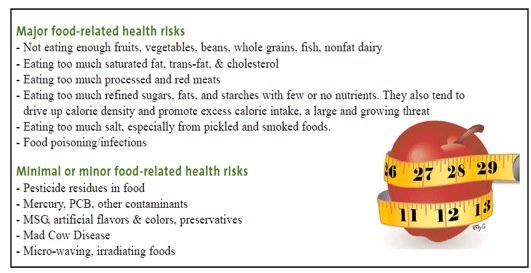Sadly many Americans are irrationally afraid of adverse health effects from consuming many food additives such as MSG, pesticide residues on fruits and vegetables, and mercury, PCBs and other contaminants in seafoods. They often pay premium prices for "organically grown" foods that promise (often without merit) to be free of pesticide residues. In fact, there is no credible evidence that pesticide residues on fruits and vegetables pose a significant health threat. Indeed, the more fruits and vegetables people eat the lower their risk of developing several common types of cancer. So people who limit their intake of fruits and vegetables because they cannot find and/or afford those that are "organically grown" are likely increasing their risk of cancer and other ills.
Certainly there is reason to suspect that mercury, PCBs, and other contaminants in seafoods can pose a modest risk to the developing fetus, babies and young children but the risk is mainly from the large predatory fish like sharks, swordfish, bluefin tuna, tilefish, etc. The amount of possible toxins in most salmon, trout, sardines, herring, mackerel, and most shellfish is too small to pose any real risk. Certainly the risk is less than avoiding all seafood and so ending up deficient in long-chain omega-3 fatty acids, which have results in known ill effects on brain and eye development. Low intake of omega-3s in older men and women increase the risk of dying of a heart attack by 30 to 50% and are linked to an increased risk of several types of cancer and possibly Alzheimer's disease too.It is sad many Americans avoid MSG and buy foods loaded with salt. Excess salt in the diet: (1) is the primary cause of hypertension, which is the #1 risk factor for stroke and a major risk factor for coronary artery disease and heart failure; (2) promotes atrophic gastritis, which often leads to stomach cancer and vitamin B-12 deficiency; (3) increases the loss of calcium in the urine, which contributes to the development of kidney stones and probably osteoporosis as well; (4) Hypertension is also associated with an increased risk of kidney failure, damage to small blood vessels in the eyes and brain contributing to blindness and senility; (5) is a major promoter of reflux esophagitis, which is the #1 risk factor for esophageal cancer; (6) is known to promote headaches and edema. By contrast, MSG consumed in moderation has never been shown to increase the risk of dying. About the worst thing that happens from consuming too much MSG is an unpleasant reaction in a small percentage of people lasting a few hours at most. Unlike salt MSG does not appear to promote hypertension, cardiovascular disease, cancer, kidney stones, or reflux disease. It is likely a survey of Americans would show most believed sea salt was far healthier than MSG, when in fact sea salt is mostly salt and at least in animals appears just as likely to promote hypertension.Fortunately a growing number of Americans are increasingly trying to avoid partially hydrogenated vegetable oils. These are proven to adversely impact blood lipids and no doubt contribute to coronary heart disease. What is odd is that many of the same people who avoid these "bad" man-made fats think nothing of consuming diets loaded with fatty red and processed meats, cheese, butter, ice cream, eggs, tropical oils, and other foods loaded with saturated fat and cholesterol. The adverse effects from the saturated fat and cholesterol in the average American diet has far more adverse effects on their blood lipids and risk of heart disease than the relatively small amount of trans fats they have cut from their diets.
Bottom Line:Far too many Americans are oblivious to the concept of relative risk and waste their time and money religiously avoiding many food components that pose little or no risk to their health and longevity. By contrast, many Americans continue to consume unhealthful amounts of refined carbohydrates, salt and saturated fat and not nearly enough fruits, vegetables, and most seafoods, because of overblown fears about contamination from pollutants. It is the role of the dietitian to explain the concept of relative risk to their clients and help them make more informed and healthy food choices.By Dr. James J. Kenney, PhD, RD, FACN.Major food-related health risks- Not eating enough fruits, vegetables, beans, whole grains, fish, nonfat dairy- Eating too much saturated fat, trans-fat, & cholesterol- Eating too much processed and red meats- Eating too much refined sugars, fats, and starches with few or no nutrients. They also tend to drive up calorie density and promote excess calorie intake, a large and growing threat- Eating too much salt, especially from pickled and smoked foods.- Food poisoning/infectionsMinimal or minor food-related health risks- Pesticide residues in food- Mercury, PCB, other contaminants- MSG, artificial flavors & colors, preservatives- Mad Cow Disease- Micro-waving, irradiating foods



